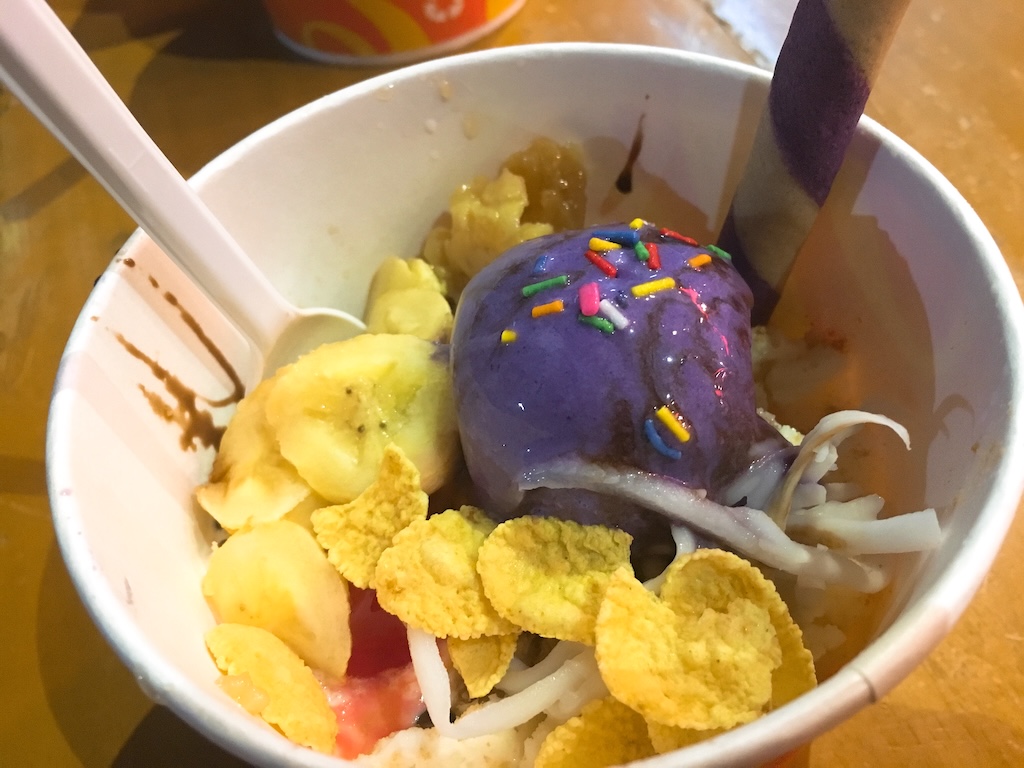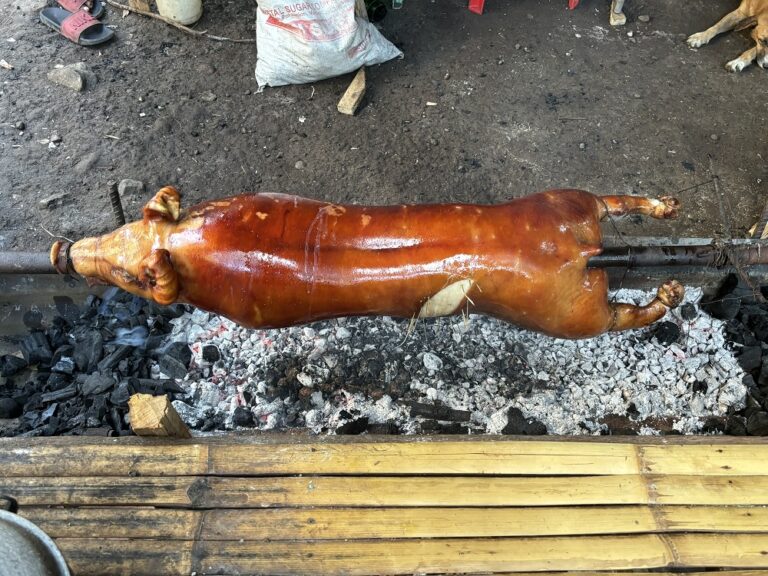Discover the Charm of Halo-Halo: A Colorful Filipino Dessert with Deep Cultural Roots
Discover the Charm of Halo-Halo: A Colorful Filipino Dessert with Deep Cultural Roots
Sweet, icy, and vibrant—Halo-Halo is the ultimate tropical treat to explore this summer.
1. What Is Halo-Halo?
A colorful chaos of flavor born from joyful mixing
“Halo-Halo” comes from the Tagalog word meaning “mix” or “to mix things together.”
True to its name, this dessert is all about layers—a medley of colorful ingredients stacked in a tall glass, meant to be stirred up and enjoyed as one vibrant, icy treat.
The first thing that catches your eye is the color.
Purple, red, yellow, white, green—it’s like a pastel painting in a cup.
The striking visual appeal often surprises first-timers and makes it a must-snap moment.
🧊 The Concept: Cold + Sweet + Crunchy
The base of Halo-Halo is made with finely shaved ice—more textured than Japanese kakigori, almost crunchy—and topped with a generous amount of evaporated milk or sweetened condensed milk.
Then come the layers of ingredients: sweetened beans, tropical fruits, colorful jelly, coconut strips, and chewy bits, all topped off with leche flan (Filipino flan) and ube (purple yam) ice cream.
Although it may look like a tropical parfait, the flavor experience is unique—a mix of pudding, crushed ice, sweet soup, chewy jelly, and creamy ice cream in a single spoonful.
It may seem chaotic, but somehow it all works in harmony—and that’s exactly what makes Halo-Halo so irresistible.
🍨 The Right Way to Eat It? Stir It Up!
Many first-time eaters hesitate to ruin the beautiful layers, but in true Filipino style, mixing it all together is the correct way to enjoy Halo-Halo.
Stirring thoroughly allows the ice, milk, and various ingredients to blend, creating a balanced sweetness and texture in every bite.
Locals even joke that if you don’t mix it well, you’ll be seen as a beginner.
(Of course, there’s no wrong way—it’s all about personal taste!)
🌞 Why It’s So Special to Filipinos
In a hot and humid country like the Philippines, cold desserts are more than just a treat—they’re a luxury.
For many Filipinos, Halo-Halo is not just about flavor; it’s about sharing a moment.
It’s commonly enjoyed with friends or family, often during special outings or lazy afternoons.
In this sense, Halo-Halo becomes a symbol of connection and warmth, where people bond over spoons and smiles.
📸 A Social Media Darling in the Age of Aesthetics
In recent years, Halo-Halo has also become a hit on Instagram and TikTok.
The signature purple ube ice cream makes it visually iconic, especially when paired with vibrant jellies and shaved ice.
Across Cebu and Manila, you’ll now find everything from modern dessert bar versions to high-end “halo-halo cocktails”, attracting both locals and international visitors with an eye for flavor and flair.
2. Essential Ingredients in Halo-Halo
A colorful blend where every ingredient has a role to play
One of the most fascinating things about Halo-Halo is the chaotic mix of textures, colors, and flavors packed into a single glass.
First-timers are often surprised by the sheer number of ingredients—and how well they actually work together.
Let’s take a closer look at the essential components that give Halo-Halo its unique charm:
🟣 1. Ube Ice Cream
The most iconic topping in Halo-Halo, this bright purple yam-based ice cream is both creamy and slightly sticky.
Made from native Filipino purple yam, ube has a rich, earthy sweetness that pairs beautifully with coconut milk and crushed ice.
💡 Locals often say: “It’s not Halo-Halo if there’s no ube on top!”
🍮 2. Leche Flan
This Filipino-style flan, influenced by Spanish cuisine, is made with egg yolks and condensed milk.
Silky and sweet, it adds richness and depth to the dessert and serves as Halo-Halo’s “flavor anchor.”
🟤 3. Saba Banana
Unlike the bananas you may know, saba is a cooking banana with a naturally sweet flavor.
Often boiled or caramelized, it brings a soft, starchy texture—like a mini candied dessert inside your Halo-Halo.
🟠 4. Sweetened Beans
Think red mung beans, chickpeas, or kidney beans—all sweetened and softened.
If this sounds unusual in a dessert, think of it as similar to Japanese zenzai.
These beans add a warm, earthy contrast and increase the variety of textures.
🟡 5. Nata de Coco
Made from fermented coconut water, nata de coco is jelly-like, chewy, and refreshing.
With its subtle sweetness and bouncy texture, it lightens the overall richness of Halo-Halo.
🔴 6. Gulaman (Colorful Jelly)
Gulaman is a Filipino version of agar jelly, often dyed red, green, or yellow.
It adds crunch, color, and a fun, playful vibe that makes Halo-Halo especially popular with kids.
🔵 7. Sago (Tapioca Pearls)
Small, chewy balls similar to boba, sago adds bounce and texture.
Paired with ice cream or fruit, it enhances the dessert’s chewiness and variety.
🟠 8. Jackfruit (Langka)
Native to Southeast Asia, jackfruit has a sweet aroma and a banana-like taste.
Its fibrous yet soft flesh adds a tropical flair to the mix, offering both sweetness and a unique scent.
🧊 9. Crushed Ice + Evaporated Milk
Finally, no Halo-Halo is complete without its icy foundation:
Finely crushed ice drenched in rich evaporated milk.
This cold, creamy base brings all the ingredients together, balancing textures and flavors.
🌟 The result? A perfect harmony of creamy, chewy, crunchy, and cold.
✅ Endless Combinations
Some vendors go even further, adding extra toppings like:
-
Grated cheese
-
Roasted peanuts
-
Sweet corn
-
Coconut strips (macapuno)
-
Puffed rice (pinipig)
This creative flexibility is exactly why Halo-Halo has earned its title as the Philippines’ national dessert—each version is a little different, yet always delicious.
3. The Cultural Roots and History of Halo-Halo
A mixed dessert that tells the story of a multicultural nation
At first glance, Halo-Halo may look like a trendy, Instagram-ready dessert.
But dig a little deeper, and you’ll find that this beloved Filipino treat carries with it a rich history—one that mirrors the diversity and complexity of the Philippines itself.
🍧 Japanese Immigrant Influence in Pre-War Philippines
In the early 1900s, a wave of Japanese immigrants settled in various regions of the Philippines, particularly in areas like Davao and the Visayas.
These immigrants brought with them traditional Japanese desserts like kakigori (shaved ice with syrup) and sweetened beans—elements that eventually influenced what we now know as Halo-Halo.
As these flavors blended with local fruits, tropical ingredients, and American-style evaporated milk, a new kind of dessert was born—something you might call a “tropical-style Japanese zenzai.”
🇯🇵 + 🇵🇭 = Japanese dessert traditions × tropical fruits & sugar culture × American milk culture
A sweet symbol of culinary fusion.
🏝️ Cold Desserts as a Luxury in the Post-War Era
In a hot and humid country like the Philippines, cold treats were once considered a luxury.
Before refrigerators and air conditioners became common in households (around the 1980s), finding a dessert made with ice was rare and special.
That’s why Halo-Halo—made with shaved ice, condensed milk, and sweet toppings—became associated with indulgence, refreshment, and celebration.
Even today, many locals still view enjoying Halo-Halo as a reward after a long day or during special occasions.
🤝 “Mixing” as a Symbol of Multicultural Coexistence
The Philippines is a melting pot of Spanish, American, Chinese, Japanese, and Indigenous cultures.
The very act of mixing diverse ingredients into one harmonious dessert reflects the country’s multicultural identity.
Every bite of Halo-Halo offers a different texture, a new flavor—yet all coexist in a single glass.
It’s a delicious metaphor for Filipino society: diverse, layered, and beautifully unified.
💡 Halo-Halo as “Edible Sociology”
More than just a sweet treat, Halo-Halo encapsulates:
-
Colonial history
-
Global cultural exchange
-
Local diversity
-
Economic development
-
Regional creativity
It’s no exaggeration to say that Halo-Halo is more than dessert—it’s a cultural icon of the Philippines.
4. Where to Try Halo-Halo in Cebu: 5 Spots Loved by International Students
Taste and experience change depending on where you eat—here’s your guide to finding your perfect bowl
Cebu has no shortage of places to try Halo-Halo.
But what’s truly fascinating is how each shop puts its own spin on the dessert—from traditional versions to modern, Instagram-ready creations.
Here are five great options that are popular with local students and international visitors alike:
✅ 1. Chowking
A reliable classic—perfect for first-timers
This Chinese-Filipino fast food chain offers a well-balanced, widely loved version of Halo-Halo.
It features all the essentials—ube ice cream, leche flan, crushed ice, jelly, and more—layered beautifully in a large serving.
It’s affordable (around PHP 100), generously portioned, and easy to find all over the country.
Highly recommended as your “first Halo-Halo experience.”
🗣️ “Chowking was the first Halo-Halo I ever had in the Philippines. I keep going back—it’s that good.”
— Korean student, female
✅ 2. Razon’s of Guagua
Minimalist and refined—Halo-Halo for grown-ups
This famous Manila-based chain is known for its stripped-down, elegant version of Halo-Halo.
With just three ingredients—milk, sweetened saba banana, and leche flan—it offers a silky-smooth experience unlike the more colorful versions.
Its fine ice and creamy texture make it ideal for those who prefer subtle, sophisticated flavors.
You’ll find it at major malls like SM City Cebu.
🗣️ “The soft shaved ice and silky flan were unforgettable. Even with just a few ingredients, it felt complete.”
— Taiwanese student, male
✅ 3. Mang Inasal
Hidden gem for dessert at a grilled chicken joint
Known for its grilled chicken meals, Mang Inasal also serves a surprisingly good Halo-Halo.
Perfect as a light dessert after lunch or dinner, it’s smaller in portion and very budget-friendly (PHP 60–80).
Great for those who want a quick, tasty option without going out of their way.
🗣️ “I didn’t expect much, but their Halo-Halo was really tasty—and just the right size.”
— Japanese student, male
✅ 4. Larsian Food Court
Local vibes, simple ingredients, unforgettable experience
Larsian is a well-known street food hub in central Cebu.
After enjoying local BBQ, several stalls offer no-frills, homemade-style Halo-Halo.
It may not look fancy, but the taste—and the experience—feel authentic and memorable.
🗣️ “Eating Halo-Halo with locals on a bench—it wasn’t fancy, but it felt like the most ‘Filipino’ moment of my trip.”
— Saudi Arabian student, male
✅ 5. Dessert Factory / La Marea
Stylish, indulgent, and perfect for your Instagram feed
If you’re in the mood for a premium treat, check out Cebu’s café-style Halo-Halo options.
At places like La Marea or Dessert Factory, you’ll find ube gelato, biscuits, sauces, and artistic presentations.
Prices are higher (around PHP 200), but perfect for café hoppers or those looking for a luxurious, photogenic dessert.
🗣️ “I came for the Instagram pic, but stayed for the flavor. This was ‘luxury Halo-Halo’ done right.”
— Vietnamese student, female
📌 Find Your Perfect Halo-Halo Experience
-
First time? → Try Chowking
-
Love simplicity? → Go for Razon’s
-
On a budget? → Mang Inasal is perfect
-
Want local flavor? → Don’t miss Larsian
-
Craving something fancy? → La Marea or Dessert Factory
Halo-Halo isn’t just about the ingredients—it’s also about where you eat it, who you share it with, and what moment it marks in your experience.
Find your favorite. And make it part of your Cebu story.
5. How to Fully Enjoy Your First Halo-Halo
A tropical dessert meant to be seen, mixed, and savored with all five senses
Halo-Halo is more than just a dessert—it’s an experience.
And if you’re visiting the Philippines, you owe it to yourself to enjoy this colorful treat the way locals do.
Here are some tips to help you get the most out of your first Halo-Halo:
🍨 1. Start by admiring it with your eyes
Take a moment before diving in.
Notice the deep purple of the ube ice cream, the colorful jellies, the bright yellow flan, and the crushed white ice.
It’s a visual celebration of Filipino flavors and textures.
📸 Pro tip: This is the perfect time to snap a photo for your socials.
Try a top-down shot or a scoop-in-progress with visible layers—it’s guaranteed to get likes.
🥄 2. Mix it up—seriously!
Halo-Halo literally means “mix-mix,” and that’s the secret to its magic.
Once you stir everything together—ice, milk, flan, fruits, beans, jelly, bananas—you’ll discover a harmony of cold, sweet, chewy, and creamy textures in every bite.
You might feel guilty ruining the beautiful layers, but trust us—Halo-Halo reaches its full potential only after it’s thoroughly mixed.
🍧 3. Create your own “eating style”
While mixing is traditional, some prefer a more layered approach—tasting the toppings one at a time.
Especially with rich flavors like ube or leche flan, it’s okay to sample first and then stir.
🔄 Whether you’re a “full mixer,” a “top-down explorer,” or someone who saves the best for last,
finding your personal Halo-Halo style is part of the fun.
🧊 4. Don’t wait too long—the ice melts fast!
In the tropical heat, shaved ice can quickly turn into a sugary soup.
Start eating while the ice is still solid to enjoy the perfect crunchy-chilly texture.
If the flavor gets too light, dig into the bottom—that’s where the sweetened beans and jellies are hiding.
👫 5. Share it with friends—it’s better that way
Halo-Halo servings are often generous, and many locals casually share one glass among two or three people.
It’s a natural way to bond: “What’s this one?” “Try this jelly!”—conversation flows easily over dessert.
In Filipino culture, eating together builds connection.
Even if you’re shy about speaking English, sharing Halo-Halo can break the ice—literally and socially.
✅ Final Tip: Think of Halo-Halo as a cultural experience, not just dessert
It’s more than flavors—it’s about:
-
Trying new ingredients you’ve never seen before
-
Ordering in English
-
Immersing in a local atmosphere
-
Being surprised by something totally unfamiliar
Each of these adds value to your study abroad journey—not just as a student, but as a traveler and a cultural explorer.
📌 Find Your Own Halo-Halo Experience
Halo-Halo is more than a dessert—it’s a reflection of the Philippines itself.
Colorful. Diverse. Full of surprises.
Each ingredient has a unique personality, yet blends perfectly with the others in one cup—just like the multicultural spirit of the country.
☑︎ Choose your Halo-Halo, your way:
-
Want to start with a classic? → Chowking
-
Prefer something minimalist and elegant? → Razon’s
-
Looking for a quick, light dessert after lunch? → Mang Inasal
-
Craving an authentic street food experience? → Larsian
-
Need something fancy for your Instagram? → La Marea / Dessert Factory
Every shop tells a different story.
Depending on your mood, budget, or travel vibe, you’ll find a Halo-Halo that feels just right.
🌏 Halo-Halo is the perfect entry point to Filipino culture
For international students, enjoying Halo-Halo is more than satisfying your sweet tooth.
It can be:
-
A chance to practice English by ordering
-
A reason to talk to locals and ask for recommendations
-
A shared memory that brings people together
These little moments can go a long way in helping you feel more connected—both to people and to place.
💬 So, what will your first Halo-Halo memory be?
There’s no right or wrong way to eat it.
Stir it. Don’t stir it. Love it or find it strange.
Whatever your experience, it brings you a little closer to the heart of the Philippines.
When you return home, you might forget some grammar rules or class notes.
But that one sweet, cold, colorful dessert—shared with friends on a hot day—just might stay with you forever.


